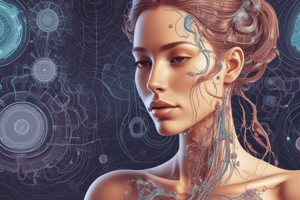Podcast
Questions and Answers
What is the primary function of the vas deferens?
What is the primary function of the vas deferens?
- Carrying urine from the bladder to the outside of the body
- Carrying mature sperm from the epididymis to the pelvic cavity (correct)
- Producing fluid that adds to semen during ejaculation
- Contributing up to 80% of the fluid in semen
Which male organ is responsible for temperature regulation to ensure optimal sperm production?
Which male organ is responsible for temperature regulation to ensure optimal sperm production?
- Epididymides
- Testicles
- Penis
- Scrotum (correct)
Where are the seminal vesicles located?
Where are the seminal vesicles located?
- Surrounding a portion of the urethra
- Connected to the epididymis
- Near the base of the bladder (correct)
- In the pelvic cavity
Where is the opening of the urethra located in the male reproductive system?
Where is the opening of the urethra located in the male reproductive system?
Which hormone primarily stimulates the development of secondary sex characteristics in males?
Which hormone primarily stimulates the development of secondary sex characteristics in males?
What is the primary function of the epididymides in the male reproductive system?
What is the primary function of the epididymides in the male reproductive system?
Which part of the penis contains sensitive nerve endings?
Which part of the penis contains sensitive nerve endings?
What is the role of the prostate gland in male reproductive system?
What is the role of the prostate gland in male reproductive system?
What is the function of the testicles in the male reproductive system?
What is the function of the testicles in the male reproductive system?
Which gland surrounds a portion of the urethra and contributes to semen during ejaculation?
Which gland surrounds a portion of the urethra and contributes to semen during ejaculation?
In addition to testosterone, which hormone is regulated by gonadotropin-releasing hormone (GnRH) in males?
In addition to testosterone, which hormone is regulated by gonadotropin-releasing hormone (GnRH) in males?
Where are the paired testes located in the male reproductive system?
Where are the paired testes located in the male reproductive system?
Study Notes
Male Reproductive System: Understanding Its Structure and Functionality
The human reproductive process involves two types of sex cells, or gametes, which are the male gamete (sperm) and the female gamete (egg or ovum). The male reproductive system consists of external and internal organs that play crucial roles in sexual function, urination, and biological reproduction.
External Organs
Penis
The penis is the primary organ for sexual intercourse and ejaculation. It contains sensitive nerve endings and has three main parts: root, body, and glans. The opening of the urethra, where semen exits during ejaculation, is located at the tip of the penis.
Scrotum
The scrotum is a loose sac of skin that holds the testicles and supports their descent. It plays a crucial role in temperature regulation for optimal sperm production by keeping the testes slightly cooler than body temperature.
Testicles
Located within the scrotum, the paired testes produce millions of immature sperm cells called spermatids through a process known as spermatogenesis. Each testicle is connected to the epididymis, a coiled tube that stores and matures sperm.
Internal Organs
Epididymides
These structures lie on the back of each testicle and transport mature sperm to the vas deferens.
Vas Deferens
A long muscular tube, the vas deferens carries mature sperm from the epididymis to the pelvic cavity, where it joins with seminal vesicle ducts to form ejaculatory ducts.
Seminal Vesicles
Two sac-like pouches attached to the vas deferens near the base of the bladder, seminal vesicles contribute up to 80% of the fluid in semen, providing energy for sperm movement.
Prostate Gland
The walnut-sized prostate gland surrounds a portion of the urethra and produces fluid that adds to semen during ejaculation.
Urethra
The tube carrying urine from the bladder to the outside of the body also serves as the passageway for semen during ejaculation.
Hormonal Regulation
The male reproductive system relies heavily on hormones, primarily testosterone, which stimulates the development of secondary sex characteristics and promotes sperm production. Other important hormones include follicle-stimulating hormone (FSH) and luteinizing hormone (LH), regulated by gonadotropin-releasing hormone (GnRH) from the hypothalamus.
Importance of the Male Reproductive System
Beyond its obvious role in producing children, the male reproductive system contributes significantly to overall health and wellbeing. It determines many physical traits, beginning in childhood, and maintaining its health helps ensure a satisfying life.
Conclusion
Understanding the structure and functions of the male reproductive system provides valuable insights into its essential roles in human biology. From sexual function and urination to the creation of new life, these systems play vital roles in shaping the human experience.
Studying That Suits You
Use AI to generate personalized quizzes and flashcards to suit your learning preferences.
Description
Test your knowledge on the structure and functionality of the male reproductive system. Learn about the external and internal organs involved in sexual function, urination, and sperm production. Explore the hormonal regulation and overall importance of the male reproductive system.




